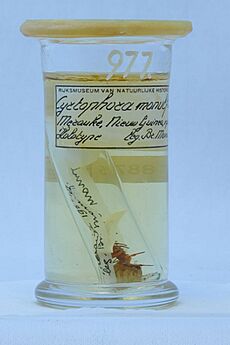Father Chrysanthus facts for kids
Quick facts for kids Chrysanthus |
|
 Chrysanthus holding a spider |
|
| Born | 1 September 1905 in Mill, North Brabant, The Netherlands |
|---|---|
| Died | 4 May 1972 (aged 66) in Oosterhout, North Brabant, The Netherlands |
Wilhelmus Egbertus Antonius Janssen (born September 1, 1905 – died May 4, 1972) was a Dutch priest and biology teacher. Most people knew him as Father Chrysanthus. He was a member of the Capuchin Order. Father Chrysanthus was famous for studying spiders. He first studied spiders in the Netherlands. Later, he became an expert on spiders from New Guinea. After he passed away, two types of spiders were named after him.
Contents
Early Life and Education
Wilhelmus Egbertus Antonius Janssen was born in Mill, North Brabant, Netherlands. This was on September 1, 1905. From 1918 to 1924, he studied at a school for future priests. On September 7, 1924, he joined the Order of Friars Minor Capuchin.
After studying philosophy and theology, he became a priest. This happened on March 12, 1932. He lived at the Capuchin Order's monastery in Oosterhout. Father Chrysanthus taught biology at the minor seminary from 1932 until 1972. Today, this school is called Sint-Oelbertgymnasium.
Studying Spiders: Father Chrysanthus's Research
Father Chrysanthus started studying Dutch spiders in 1939. He was inspired by a book called Aus dem leben der Spinnen. This book was written by Fritz Lock and came out the same year. Chrysanthus began by writing for magazines like De Levende Natuur.
In 1950, he wrote a book called Spinachtigen en Duizendpoten. This means "Arachnids and Centipedes." It was part of a series called Wat Leeft en Groeit. The book received good reviews. Peter J. van Helsdingen called it "excellent" in 1977.
Chrysanthus's book Nederlandse Spinnen ("Dutch Spiders") was first published in 1954. It was written for the Koninklijke Nederlandse Natuurhistorische Vereniging's Wetenschappelijke mededelingen series. More editions came out in 1963, 1971, and 1980. A Dutch insect expert, Barend Lempke, gave good reviews to all four editions.
Focusing on New Guinea Spiders
In 1957, Father Chrysanthus became very interested in spiders from New Guinea. This happened after Brother Monulf sent him a collection of spiders. Monulf had gathered these spiders while doing missionary work in Merauke and Mindiptana. These places are in Western New Guinea. Chrysanthus had met Monulf earlier in 1953.
To learn more, Chrysanthus visited natural history museums. He went to museums in Frankfurt, Genoa, London, and Paris. He looked at their spider collections.
Missionaries, museum visitors, and science trips also sent him new spider collections. Museums were eager to give him specimens. This was because they did not have many experts on New Guinea spiders. Researchers often asked him to help identify spiders from New Guinea. These researchers included Ralph Bulmer, Yael Lubin, and Michael H. Robinson.
In 1982, Michael H. Robinson wrote that Chrysanthus did "almost all of the recent work" on New Guinea spider classification. He also said that after Chrysanthus died, no one knew as much about these spiders.
Understanding Spider Species
Father Chrysanthus also helped with taxonomy, which is the science of classifying living things. He showed that two spider types, Metellina mengei and Metellina segmentata, were truly different species. Before his work, some thought they were just variations of the same type. He published this finding in a 1953 paper.
Because of his analysis, other experts like G. H. Locket and A. F. Millidge changed their minds. They listed these spiders as separate species in their book British Spiders.
Chrysanthus also worked on spiders in the genus Coelotes. He helped clear up confusion about C. atropos, C. saxatilis, and C. terrestris. This was published in a 1965 paper. His work led to a proposal in The Bulletin of Zoological Nomenclature. In 1979, an international group accepted his proposal.
Contributions to the Scientific Community
In 1955, Chrysanthus joined the team that edited the journal Tijdschrift voor Entomologie. He stayed in this role until 1971. He attended the first international meeting for spider scientists in Bonn, Germany, in 1960. He was the only person there who was not German. In 1965, he went to another spider congress in Frankfurt.
He was also a visiting researcher at the Naturmuseum Senckenberg. He became a member of the Netherlands Entomological Society in 1946. In 1967, he was given a special position at the Rijksmuseum van Natuurlijke Historie.
During his life, Father Chrysanthus wrote over one hundred scientific papers. The World Spider Catalog lists 77 species that he described. As of 2022, 64 of these names are still considered valid.
Death and Legacy
Father Chrysanthus passed away on May 4, 1972. He was 66 years old. He died in his monastery in Oosterhout after being sick for a long time.
Ludwig van der Hammen and Peter J. van Helsdinger wrote about his death in Entomologische Berichten. Van Helsdinger also wrote an obituary for another journal.
Chrysanthus's collection of New Guinea spiders is now at the Rijksmuseum van Natuurlijke Historie. His collection of spiders from South Limburg is at the Maastricht Natural History Museum. His books were given to the university library in Nijmegen.
In 1981, two Indian spider experts, B. K. Tikader and Animesh Bal, named a spider species after him. They called it Neoscona chrysanthusi. They did this to show their great respect for him. In 1982, G. H. Locket named another species Nasoona chrysanthusi. He did this "in affectionate memory of the late Father Chrysanthus and in admiration of his work on New Guinea spiders."


